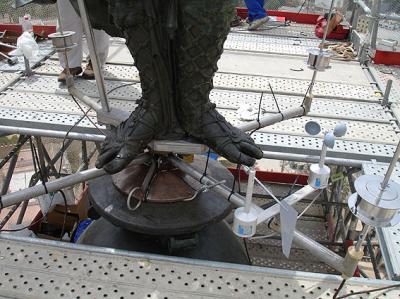Mar 7 2010
A team of engineers from the University of Seville (US) has created a system for monitoring historical monuments by remote control and detecting possible damage.
Five years ago the researchers placed various sensors on the Giraldillo, the sculpture that crowns the Giralda, and now they are publishing the results in the journal Structural Health Monitoring.
 System for monitoring historical monuments by remote control. Image Credit: Solis et al.
System for monitoring historical monuments by remote control. Image Credit: Solis et al.
"The system has been connected to the Giraldillo to register different variables associated to the mechanical response of this sculpture, such as meteorological actions or conditions that it is subjected to, but it could be used to monitor other historical monuments", Mario Solís, main author of the study and professor at the Escuela Técnica Superior de Ingenieros (Advanced Technical College for Engineers) of the US, explained to SINC. The Giraldillo, a Renaissance sculpture that acts as a weather vane on the top of the Giralda, was taken down and restored between 1999 and 2005, at which point the researchers took the opportunity to put on sensors which have allowed them to monitor it up until now.
The results of the study, published in the last edition of the journal Structural Health Monitoring, indicate that the weather vane sculpture requires a wind speed of 10 m/s to move and positions itself according to this meteor 40% of the time, the temperature fluctuates from 0ºC registered on the exterior to 48 ºC measured by an internal probe, and no abnormal values are recorded in the vibration frequencies and the mechanical response.
"The system provides information of great interest for studying the behaviour and state of preservation of the Giraldillo", Solís highlights, which confirms that this technique "could not only be applied to detect structural damage in other monuments of historical heritage, but also in machinery and aero spatial components".
How to monitor the Giraldillo
To determine the environmental conditions surrounding the statue, the scientists installed two temperature and humidity probes (one external and another on the inside of the ball on which it stands), and a third to calculate the corrosion of the bronze pieces that it is composed of. The cables for the sensors are centralised in a terminal with a 40 metre cable leading into the data acquisition system. This is located in the Body of the Clock of the Giralda, the highest point of the tower, which can be easily accessed to carry out programming and maintenance tasks. From there, through an internet connection or via traditional remote control information can be sent to any control centre.
The magnitudes registered are velocity and direction of the wind (this is the main mechanical action that impacts the monument), the degree of flexion of the rod that supports the statue on the tower (to detect curvatures), and the measurement of vibrations, through six accelerometers and four levels.